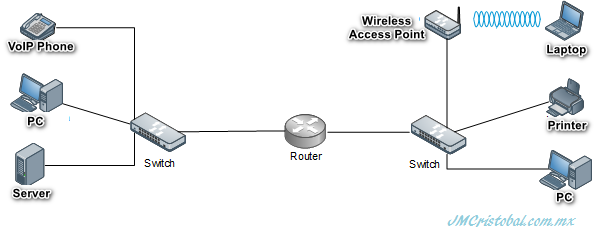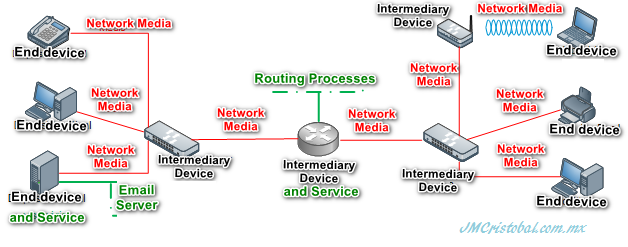A computer network is a group of computers (PCs) or similar devices connected to access and share network resources, such as files, storage space, printers, IP telephony, and email, among other services.
An example of a network is the following:

Each computer in a network is called a host or end device. To understand how communication is established between the different devices in a network, it is necessary to know the components or elements of the network. Absolutely all messages are converted to digital signals encoded in binary code (bits) and then sent through all network components.
The components or elements of the network are:
- Devices .- These are physical elements, i.e., hardware, and are generally visible within the network, so we can also classify them into:
- End devices. – Also called hosts, they are the equipment that regularly initiates communication in the network. We constantly use in our daily life, for example, personal computers, laptops, smartphones, tablets, printers, cameras, video game consoles, SmartTVs, servers, IP phones, etc.
- Intermediary devices. – These devices are less visible to people in general because they interact behind the end devices; the intermediate devices are the ones that connect the hosts or end devices to the network. The intermediate devices also can connect two or more networks to create internetwork. An internetwork is the interconnection of two or more different networks. Some intermediary network devices are switches, wireless access points, routers, modems, firewalls, etc.
- End devices. – Also called hosts, they are the equipment that regularly initiates communication in the network. We constantly use in our daily life, for example, personal computers, laptops, smartphones, tablets, printers, cameras, video game consoles, SmartTVs, servers, IP phones, etc.
- Network Media – These are responsible for transmitting messages from one network device to another. Copper, fiber optics, and wireless transmission are the most commonly used media. Previously we mentioned that the messages are converted into bits before sending them over the network. When the messages have already been converted to binary code, the copper coding is through electrical pulses, fiber optic transmissions with light pulses, and wireless transmissions through electromagnetic waves. In the case of wireless means, the transmission is carried out utilizing invisible waves, contrary to copper and optical fiber, through a physical cable.
– - Services: These communication programs, called software, run on the devices connected to the network. Services include a large number of typical network applications that people use daily, such as email services, forums, chats, and instant messaging, among others.
Talking about end devices, as well as intermediate devices running services that are not visible to the end user but are of vital importance, for example, the switches switch through software, the communication between two or more end devices, quality of service (QoS) and more, on the other hand, the router has the function of finding the closest route to reach or reach a different network, and as we said before, these processes are less evident to us.
Taking the previous image as a reference, the elements of a network are shown graphically below:

In conclusion, the services in the network must be accompanied by devices and means to carry out the communication. Still, there is a very important point that we need to mention: interconnected devices must have rules to process the information. These rules are called protocols and are used by network devices to communicate with each other.
Currently, the standard in the networking industry is TCP/IP (Transmission Control Protocol/Internet Protocol), the leading Internet standard. TCP/IP is responsible for formatting, addressing, and routing our messages to reach their correct destination.